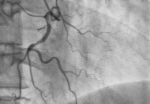There is a consistent number of patients presenting high risk of bleeding. In this context, receiving dual antiplatelet therapy (DAPT) for 12 months would not be advisable. Even though the European and American guidelines recommend 1 to 6 months for chronic and acute syndromes in this group, these are often complex PCI cases, which makes...
Safety of Acetylcholine in the Cath Lab
The concepts of ischemia with non-obstructive coronary artery disease (INOCA) and myocardial infarction with non-obstructive coronary artery disease (MINOCA) have been established, widely spread, accepted, and included in the different guidelines that support our clinical practice. Among INOCA and MINOCA we find vasospastic angina (VSA) caused by epicardial vessel spasms and angina caused by microvascular...
FFR and IFR: Are We Talking About the Same Thing?
To evaluate borderline coronary lesions (a 40% to 70% obstruction), determining associated ischemia is paramount. For this purpose, pressure gradients are measured across the stenosis. These measurements can be hyperemic, such as the fractional flow reserve (FFR), or taken at rest, such as the instantaneous wave-free ratio (iFR). According to the iFR-SWEDEHEART 5-year follow-up outcomes,...
When is the Ideal Timing for NSTE-ACS Percutaneous Intervention?
According to the European Society of Cardiology (ESC Guidelines 2021) an early invasive strategy is recommended (<24h) for high-risk patients with acute coronary syndrome with no ST elevation (NSTE-ACS), namely patients presenting a rise or fall in cardiac troponin, dynamic ST- or T-wave changes and GRACE risk score >140. Early intervention (<2h) is reserved for...
Transfemoral vs Transradial Approach in the Percutaneous Treatment of CTO
Percutaneous treatment of chronic total occlusion (CTO) has traditionally been via the transfemoral approach (TFA). The use of the transradial approach (TRA) in complex coronary interventions has been increasing. A randomized study assessed the use of TRA vs TFA in complex PCI (58% CTO) and TRA saw favorable outcomes. The aim of this prospective, randomized,...
IVUS-Guided Coronary Angioplasty: Promising Results at 3-Year Follow-Up
Intravascular ultrasound (IVUS) to guide drug-eluting stent (DES) implantation has been evaluated in several studies. Two randomized studies, IVUS-XPL (Impact of Intravascular Ultrasound Guidance on the Outcomes of Xience Prime Stents in Long Lesions) and ULTIMATE (Intravascular Ultrasound Guided Drug Eluting Stents Implantation in All-Comers Coronary Lesions), have shown fewer repeat revascularizations compared with angiography-guided...
Drug Eluting Stents: Does Strut Size Matter?
The benefit of first-generation Drug-Eluting Stents (DES) over Bare Metal Stents (BMS) is largely known. Moreover, technological developments have led to reduced strut size, biodegradable polymers, and new scaffolds, which in turn have led to improved outcomes. These are known as ultrathin stents, and its struts measure between 70 and 100 microns, which contributes to...
Zwolle Score: Can a Risk Score Decide Where STEACS Patients Should Stay?
The mortality of ST-segment elevation acute coronary syndromes (STEACS) has decreased thanks to improved reperfusion times (fibrinolysis or primary angioplasty), so that, in daily practice, there is a greater number of patients with stable acute myocardial infarction (AMI). This clinical stability and a low rate of complications raise the question of whether performing triage is...
IVUS in Acute Coronary Syndrome: A New Requirement?
The use of intravascular ultrasound (IVUS) has seen exponential growth across registries over the years, combined with mounting and increasingly robust evidence. The fact that it will enable us to characterize plaque morphology and extension prior the intervention, and even assess stent expansion post intervention, has turned it into a pillar of our efforts to...
Cangrelor: Additional Research Findings Not Translating into Clinical Practice
The potent and fast endovenous platelet inhibition provided by Cangrelor reduces ischemic events early in the course of acute coronary syndrome. However, and despite mounting evidence, the drug is not reaching the clinical practice. This is a sub-analysis of the CHAMPION PHOENIX, which sought the timing, number and type of early events that could be...









